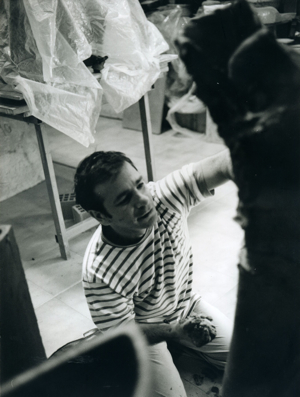
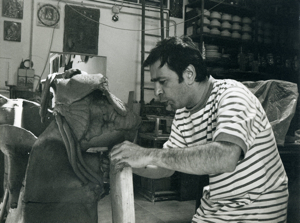
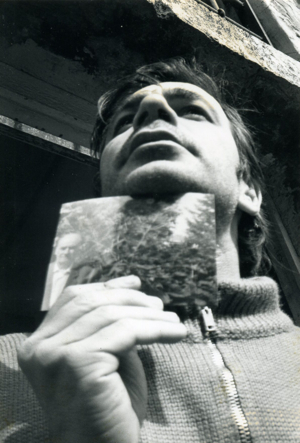
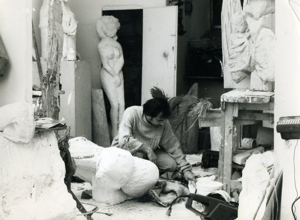
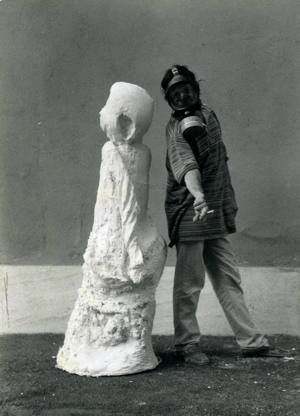
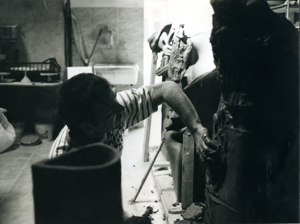
Born in Melfi (PZ, Region of Basilicata, Italy) the 18th of April 1957.
In 1971 he attended the architecture department of the Art High School of Melfi. In those early years, he spent most of his days practicing real-life drawing. In 1975 he obtained the Art High School Diploma.
In October of that same year he entered the Fine Arts Academy in Rome and attended a course in sculpture, initially with Umberto Mastroianni, and later with Pericle Fazzini.
In 1976 he took part in the researches and the setting up of the exhibition “L’Accademia di Belle Arti e l’istruzione artistica” at Palazzo Braschi in Rome.
During the Academy’s years he attended special courses in Foundry, Photography, Theory of Form, Various Techniques of Sculpture and Theory of Visual Perception; Nato Frascà held this last course.
In 1979 he completed his studies at the Academy with a dissertation on Vincent Van Gogh for the Art History course taught by Cesare Vivaldi.
He returned to Lucania [historical region of ancient Italy and included almost all of today’s Basilicata] where he began to experiment all that the Academy had given him at a theoretical level, such as performance, photography and environmental installations (cages and cubes). He focused on experimentation, inspired by masters of art history such as Duchamp, Malevich and Mondrian. He reproduced The Black Square [by Malevich], Broadway boogie-woogie [by Mondrian], Perceptive perception of a black cube painted on a white background.
In 1980, on the occasion of the Melfitana summer, he prepared three days of performances: Contrazione (Corpo su carta) inspired by Jackson Pollock, Help dedicato a J. Dine and Z.I.N.C.O.
In 1981 he was in Rome. He visited, with Nato Frascà, the International Graphic Art Studio “L’Arco” in via Mario dei Fiori – a crossroads of artists, critics and poets – where he met Giuseppe Appella.
In March 1983 he returned to Rome, at the invitation of Pietro Perrone to take part in the exhibition “Scacco matto a Casaidea” at the Fiera di Roma.
In the summer of the same year, Giuseppe Appella brought him to Castronuovo Sant’Andrea (PZ) where he held his first solo show within the walls of the ancient castle: “Dieci sculture e dieci motivi jazz di Giacinto Cerone”. On this occasion he exhibited his first copper sculptures. The opening night was filmed by RAI3 Basilicata.
In 1984 he moved to Rome and in October 1985 he married Elena Cavallo.
In 1986 he was having his studio in Vicolo del Bologna 32, in Trastevere. He contributed to the magazine “Altrimmagine” and took part in the group exhibition curated and organized by the magazine in Bari.
In the same year he was assigned to teach the art of cabinet-making, carving and inlaying at the Art Institute in Via del Frantoio.
In 1987 the Cultural Association Hobelix in Messina hosted his solo exhibition; in the same year the first two ceramics (Marsupio and Martini) were created in a small furnace in Vicolo del Moro.
He met the publisher-gallerist Maurizio Corraini and through him he came to know Giosetta Fioroni with whom he had a continuous intellectual exchange.
In the spring of 1987 he met Mauro Zammataro and Corrado Bosi: in the experimentation of new materials, their support will be absolute.
The graphic production intensified and became more and more autonomous from the sculpture.
In February 1988, with a studio visit by Ennio Borzi (director of the “Break Club” Gallery in Rome) he sold his first works in wood (Bassorilievo, Inclinata, Lupo, Monaco, Utranquilla, Piccola inclinata, Spezzacatene) and the ceramics Marsupio and Martini. On this occasion he met Barbara Tosi who will write a critical text for the book Roma Arte Oggi.
The first relationships with art critics have begun: Paolo Balmas, Martina Corgnati, Vito Apuleo, Flaminio Gualdoni.
On the occasion of the exhibition at “Graffiti now atelier” in Verona, in 1989, two new materials were introduced into his work: aluminium and cast iron.
In March 1990 the eldest son Michele was born; for this occasion he opened his first exhibition in Milan (Valeria Belvedere Gallery) entitled “San Michele”.
In 1991 he prepared his leaving with his family for Albisola [SV] where he would stay almost all summer, working at Ceramiche San Giorgio with Salino and Poggi. Some artworks produced in Albisola will be shown in autumn in Verona in an exhibition entitled “Doppi Fiumi”, others in Modena, in 1992, at the Roberto Monti Gallery in an exhibition dedicated to Hölderlin entitled “Der Adler” (L’Aquila).
During this period Raffaele Gavarro visited his studio and immediately established a professional relationship with him.
On 8 January 1993, Maurizio Corraini offered him a production of ceramics to be made at the Bottega Gatti in Faenza (RA) by Davide Servadei.
In March of the same year, he began a long working relationship with Valentina Bonomo who began to follow him assiduously to the point of showing him in his first major solo exhibition in Rome entitled “Aiaram” at the gallery in Piazza Santa Apollonia: he met the writer and art historian Mario Quesada, the collector Andrea Franchi and the poet Patrizia Cavalli.
For a short time he worked in a studio in via dei Marrucini, in the San Lorenzo district, where he prepared the artworks for the Bonomo Gallery. On his side Valerio Ricci, his student and assistant.
In April 1993 his second son, Lorenzo, was born.
In Luciano Trina’s atelier, in December of the same year, he prints monotype engravings; and, with Giosetta Fioroni, an etching for Incerti frammenti by Andrea Zanzotto.
In January 1994 he left his studio in Vicolo del Bologna and moved to Via Sebastiano Grandis 1, in Santa Croce in Gerusalemme.
The new series of artworks in plaster and moplen is born (Il mare, first horizontal sculpture, Disco con gigli, Sposa infelice, Calle appoggiate, Stele bucolica, Piazza Sonnino, Paesaggio tettonico).
The theme of Ophelia, already unveiled with the sculpture Vita di Ofelia (1993) began to be a constant in his poetics. From this comes the 1995 exhibition “Ofelia in traum” in Verona.
In the same year, he permanently withdrew from teaching.
For Valentina Bonomo he created the first ceramic jewels, unique examples: the theme was the rose. The jewels are a reason to deepen and challenge the ceramics as a material to be used for decorative objects such as the table with artichokes, the teacups of Mozart, the frames as decoration of fireplaces, etc.
During 1996 contacts with the galleries expanded (Oddi Baglioni, Rome; Bottai, Bologna; Fioretto, Padua).
His work becomes more sophisticated: he started to use lace on ceramics; the plaster works were made without the need to create a mould. Sometimes the sculptures are “populated” by icons from the stamps of objects (toys, cabbage, acanthus, artichoke, etc.), evoking the ready-made of Duchamp.
He exhibited the second horizontal artwork in Via degli Artisti, Cultural Association of the Circle of Palazzo Giovine in Turin. The sculpture was dedicated to Pino Pascali: it occupied the surface of the room with a large plaster plate made to size, forcing the visitor to look at it only from the outside. To prepare the installation he moved with his family for 10 days, hosted by the sculptor Salvatore Astore.
The idea for a horizontal sculpture was defined in 1997 with San Savino, exhibited at the gallery L’Attico of Sargentini (for Giro d’Italia) and the ceramic plates at the Galleria Oddi Baglioni (for Paginette Faentine, with a dedication to Domenico Baccarini).
Romolo Bulla visited his studio and a relationship was established that led him to collaborate: in 1998 he made the first lithographs collected in the folder Ofelia im Traum at the Bottega Bulla.
At the same time Daniela Lancioni brought him – together with Marisa Albanese and Gianni Dessì – to Naples to the Casina Pompeiana in the municipal villa and during this period talked to him about the project “Tor Bella in opera” at the Spazio per l’arte contemporanea Tor Bella Monaca in Rome. The possibility of creating a large sculptural installation fascinated him so much that he produced a small lithograph entitled Tor Bella Cosa.
Thinking about Tor Bella Monaca, he composed an artist’s book inspired by roses that he proposed to Corraini: the book would be published posthumously in 2005.
In November 1999 he began making the plaster sculpture in the Spazio per l’arte contemporanea in Tor Bella Monaca. The artwork is the monument to horizontality (300x3300x360 cm). He returns to the themes and politics of Greek sculpture: Phidias and the Parthenon. Graziano Paiella narrated with the camera the story of the days and moments of progress until the artwork is completed. The opening day, in an interview with Antonella Reda for Rai3 Notte, he said: “[…] I have never seen a work of figurative art in front of which people are clapping. The music is touching, the poetry is touching […] a picture is touching in a silent way. I have never seen anyone clapping in front of the Mona Lisa […] I would like people to clap in front of an artwork, certainly not in front of mine”.
Among those attending the opening there was Graziella Lonardi Buontempo, who immediately welcomed him as one of her favourite artists. In September 2003 he will exhibit in the group show “Incontri…dalla collezione di Graziella Lonardi Buontempo” at the Académie de France Villa Medici in Rome.
He worked for an exhibition at Casa Musumeci Greco entitled “I soffincielo” (2000): for the first time ceramics were hardened and made something else, removing any pictorial meaning from them. The Soffincielo are the first twelve platinum-plated works more similar to steel than to ceramics.
He is also preparing for his first solo show abroad at the David Gill Galleries in London, an exhibition curated and organized by Valentina Bonomo.
Ceramic artworks with inscriptions inspired by Poetry were created during this period. On a daily basis there are reinterpretations and quotations of the poems by Hölderlin, Sandro Penna, Patrizia Cavalli, Eugenio Montale, Rainer Maria Rilke, Vincenzo Cardarelli and Isabella Morra.
He dedicated to his father the 2001 exhibition in Mantua titled “Tripoli. Delle croci e delle delizie” and published, with the same title, an artist’s book for Edizioni Corraini, Mantua.
In September he was in the Nicoli factory in Carrara where he made his first and only marble production commissioned by Emilio Mazzoli.
The theme of the icons of mythology (the Argonauts) has returned in the group of artworks “Donne per la storia”, a solo show at Gasparelli Arte Contemporanea in Fano and in the exhibition “Sant’Agnese” at the Roman gallery Autori Cambi by Matteo Boetti, both from 2002.
He reunited with the poet Domenico Brancale, with whom he established a constant frequentation and a dense correspondence.
In October-December 2003 he prepared waxes for jewels made out of silver at the goldsmith Paolo Mangano.
In February 2004 Alberto Zanmatti and Giuseppe Gallo invited him to create a sculptural intervention at the Faculty of Architecture “Valle Giulia” in Rome: Una sposa infelice a Valle Giulia, a large plaster sculpture, the last artwork by Giacinto Cerone
He died in Rome on October 4, 2004.
Biographical Note curated by “ARCHIVIO GIACINTO CERONE” ©
